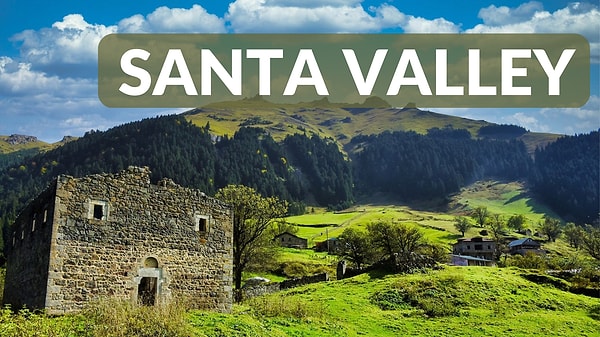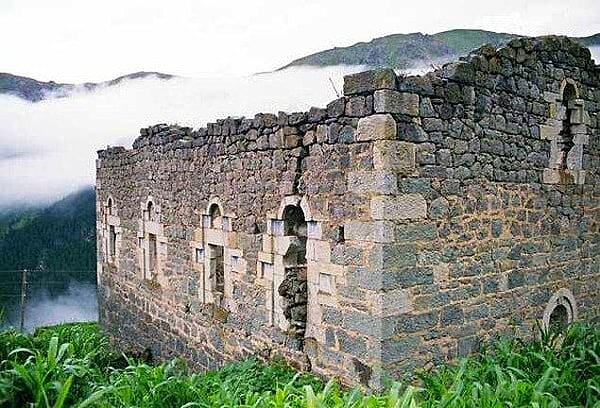Santa Ruins, which attracts attention with its history and architecture, is a mining village founded by Orthodox Christians. Declared an 'Archaeological and Natural Protected Area' in 1999 and restoration work started in October 2020, it is impossible not to be immersed in the beauty of Santa! If you love historical buildings and want to explore the beauties within the country's borders, Santa Ruins is the place for you!
Santa Valley, one of Turkey's neglected treasures and the place where hidden Christians live

Santa is still fascinating and waiting for you.

Santa Ruins, built as a mining town, is 72 kilometers from Gümüşhane and 42 kilometers from Trabzon. Built in the 17th century on three separate slopes separated from each other by the valleys where the Yanbolu Stream was born, the village fascinates its visitors with its beauty. The region, which is now called Dumanlı village, consists of 7 neighborhoods and 300 houses.
Let's take a closer look at Santa's history!

Between 1461 and 1476, during the reign of Sultan Mehmet the Conqueror, it was conquered together with the Eastern Black Sea Region and annexed to the Ottoman Empire. Between 1500 and 1800, the region, which was the most important mining settlement and lived its heyday, was evacuated with the 1923 exchange of the Orthodox Christian population to Greece. In 1924, the people of Santa, who were expelled from the region, founded a new village called Nea Santa in a place similar to Santa in Greece. Today, the ruins of Santa are only used as a plateau in the summer months.
Mining was home to many Orthodox in Santa.
Mining was instrumental in the commercial development of the village, attracting many Orthodox immigrants. Along with the available iron and lead, silver mines were also mined and processed. In the 16th and 18th centuries, the mines were operated very efficiently and provided the people with a livelihood. The region developed significantly and achieved economic prosperity. During the period when the mines were well operated, the Ottoman Empire did not neglect to provide privileges in the region. For these reasons, many migration movements took place in the region over the years.
When mining ended, agriculture and animal husbandry came to the fore in the region.
Migration continued until the 18th and 19th centuries, when the mines were closed and social and administrative problems began to arise. After the mines were closed, the region turned into a settlement where people lived off agriculture and animal husbandry. Cereals, vegetables and fruits such as pears, apples and plums, which are adapted to the altitude, began to be grown by the people of the region.
Santa attracts attention with its historical buildings in the middle of the greenery.
It is estimated that the village consisted of 9 different neighborhoods when it was founded. The area where Orthodox Christians live consists of two-storey houses made of stone. It is also possible to see a church in every neighborhood, a fountain and a school on every street. There are many monumental, religious and civil architectural structures of artistic value in the region, most of which date back to the 19th century. There are also houses built using the most accessible materials: stone and wood. However, as a result of treasure hunters and natural phenomena, only 5 of the many churches have survived to the present day. Even though they are in ruins, considering the conditions of the 17th century and the geographical difficulties, it is impossible not to be impressed by the buildings!
It is even more enjoyable to take photos with its nature and structures.
The region, which has become the center of attention of photographers in recent years, continues to host very important architectural structures, even though it has been damaged by neglect. It is thought that the region, where serious efforts are made to boost tourism activities, does not receive enough attention. For this reason, Santa Ruins was declared a first and third degree archaeological site by Trabzon Cultural Heritage Conservation Board in 1999.
The best time to visit...
If you want to visit this region where you can enjoy the greenery and fresh air, it is very important to choose the right time. The region, which is not possible to reach without a private vehicle, has bumpy roads. Spring and summer months are recommended as the most comfortable transportation times. The month with the least rainfall is August, but it is still useful to find out the weather forecast before you go!
How is transportation to Santa?
Transportation to the region takes approximately 1 hour and 35 minutes by car from Trabzon Airport. It is 131 kilometers from Rize - Artvin Airport and takes about 2 hours by car. To go to Santa Ruins from Gümüşhane city center, you first need to drive through Arzular Village. Afterwards, you can easily find the ruins by following the signs in front of you. The landscapes you will encounter during this long journey, the structures you will see in the region and the feeling that you have touched the lives of the people who lived there years ago will make the whole journey worth it!

